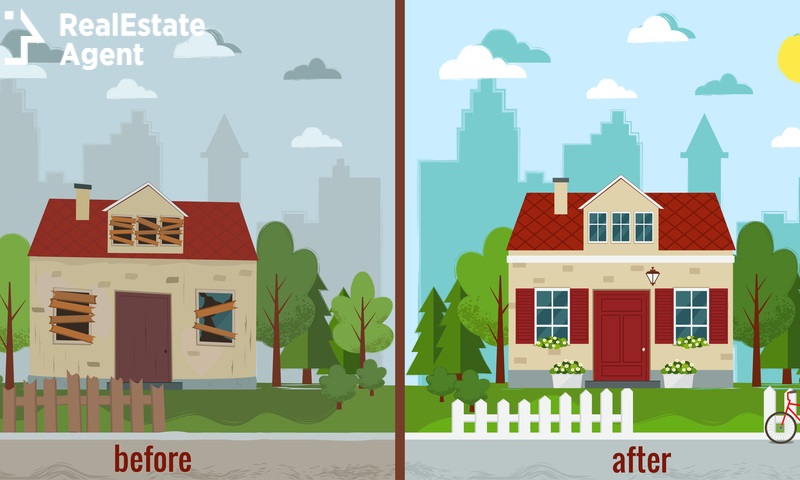You probably already know that the way to financial freedom is investing, which is nothing more than acquired assets that appreciate over time with the goal of generating income. Even though financial freedom is a bold statement and not many believe in it, all of us want to be in the financial situation that allows us to live comfortably, not from paycheck to paycheck. Becoming a successful real estate investor will definitely get you closer to living that kind of lifestyle.
Every investment involves some sort of risk, and some investments are riskier than others. Real estate for a long time has been one of the most popular areas of investment because it can generate high profit, it’s a tangible asset and it allows you to diversify your investment portfolio.
There are a variety of ways you can generate income through real estate. Some of them are appreciation, rental income, and profits generated by business activities that depend on the property. Some real estate investors take higher risks than others but usually for higher rewards if things work out well in the end. One of the higher risk and high reward real estate investments is house flipping.
We will take a more in-depth look into house flipping and see how to start flipping houses if you are just getting started. Also, we will touch on the risks of house flipping and see if it is still profitable in 2020.
What is house flipping?

House flipping is when a real estate investor buys houses with the intent of selling them for a profit. To be considered a flip, the investor needs to buy homes with the intention of selling them as quickly as possible. The time between the purchase and the sale usually ranges anywhere between a couple of months to a year.
There are two types of house flipping:
- Buying a house that can potentially increase in value after thorough repairs and updates are made. Selling the house at a much higher price compared to the initial one after all the necessary work has been done.
- Buying a house in a market that features rapidly rising prices for homes. Without doing any changes or updates to the homes, the home is listed for sale months later for a higher price than the initial one.
Having now the right idea of how house flipping works, you still have to be informed and know in which direction the real estate market in the investment area is going. You can even apply a SWOT analysis before investing in real estate to build a solid foundation and know how much potential the area has. This is a good way to practice and start learning how to flip houses as a beginner.
Risks of flipping houses

If you’re just getting started and you want to learn more about how to flip houses for beginners, you should be aware of the risks involved in flipping houses. If you want to start flipping houses you need to be aware of the risks that are involved. Everyone wants to successfully flip houses, but some things don’t always go as planned and you end up with a house flop. Here are some of the risks of flipping houses.
- Losing money instead of making a profit
This is probably the biggest risk of them all because it is basically the opposite of what house flipping is meant to do as an investment. This can come as a result of underestimating the costs needed for repairs, the time spent on a project, poor knowledge of the real estate market in the area, fluctuations in the real estate market, and so on.
- Underestimating the time and money required for a project
One of the biggest mistakes that a house flipper can do is underestimating the amount of money he has to put in in order to repair a house. Also, underestimating the amount of time it is going to take in order to complete the project and list the house for sale again.
First, there is the property acquisition cost that is quite consistent and after that, you would have to spend money to acquire the materials needed for repairing the house. Obviously, most of these expenses are expected because they have been calculated beforehand, but what if you underestimate how much you actually need to spend in order to make a profit on the house?
This is one of the big risks of flipping houses because if you do not correctly estimate the amount of money and time the project will take you might end up flooding the house. It is also a good idea to be prepared for unexpected expenses.
- Unanticipated expenses
Estimating the right amount of money that you need to put in a project is a good start on your investment, but are you prepared to deal with unexpected expenses? Yes, unexpected expenses is something you should consider when flipping houses.
Flaws that haven’t been discovered during the buying process will surely give you headaches and make you dig deeper into your pockets. Unexpected delays on any construction material deliveries is also a problem especially if you’re on the clock. Finding the right people for the job is not easy on such extensive projects. Given this type of risk when it comes to flipping houses most investors have extra cash at their disposal for unexpected expenses and delays like this.
- Difficulty selling
Even if the process went smoothly and there were no unexpected costs or delays, you still have to sell your home in order to flip the deal. Another one of the risks of flipping houses is not being able to sell, or having difficulties selling after the house has been listed. You might pay holding costs on the property and the longer it sits on the market the more money you lose on it. This might end up reducing the profit or the worst-case scenario, flopping.
What is a good return on flipping a house?

Some of the risks of flipping houses were presented above and the bottom line is that in the end, you want to have a good return on your investment. It is easier to be said than done but some of the professional house-flippers are seeing gross flipping returns of about 50% which is quite high. If you are a beginner in house flipping or if you are just getting started, don’t expect to get that much out on your first project. Remember how the old saying goes, you live and learn.
But, what would be a good return on flipping a house? What is the bottom line, a good indication that you are on the right track? Well, there is no straightforward answer to that question because there are different types of house flippers that manage their project differently, but most end up making a profit.
Some home flippers consider a 30 to 35 percent to be a good return on flipping a house. But usually more conservative investors get higher returns but less projects. Other home flippers consider a 20 percent to be a good return but they aim for volume, therefore, they end up having more projects overall.
Whatever you aim for as a return on your investment, make sure you include the total cost of acquisition, holding costs, renovation costs, and total transaction costs if for example, you are using a top local real estate agent to list and market for you.
What is the 70% rule in house flipping?

If you’re just getting started on flipping houses or even if you already have a background in this type of investment and you have never heard of the 70% rule don’t feel bad about it. The 70% rule is a term commonly used by real estate investors when flipping houses. The 70% rule is used to determine what is the correct price to pay in order to flip and make a profit.
The after repair value or the ARV is crucial for the rule to be applied. Knowing the ARV of the property is essential for it to work. The 70% rule in house flipping states that investors should pay 70 percent of the ARV of the property and subtract the repair costs from that amount. This will give a rough estimate of how much you should spend in order to make a profit from house flipping or determine if a project is not worth investing in.
For example, the ARV of a property is $200,000 and the repairs needed will cost about $30,000. If we apply the 70% rule in this scenario, 70% of the ARV of the property is $140,000, minus the repair costs we have a final amount of $110,000. Therefore, the 70% rule states that on this deal the investor should pay $110,000 for the home.
Buying a home for $110,000 and selling it for $200,000 is an amazing deal, but keep in mind what we discussed about risks and the unexpected costs that might occur during the process.
Can you flip a house with a mortgage?

The short answer is YES, you definitely are able to flip a house with a mortgage, but the question goes a little deeper. What kind of mortgages and home loans are fit for the job? Are traditional mortgage loan types going to cut it when it comes to home flipping? Most experienced home flippers consider this not to be the best way to go especially if you’re just getting started.
Loans from banks and traditional lenders are usually inexpensive and interest rates are low, but they are not always practical when you are home flipping. One of the problems with traditional lenders is the time it takes to close a loan. This is an issue since you want to hold on to a property for as little time as possible if your home flipping.
A lender loans you money if they know you have the ability to repay a loan. They assess your income and your earnings in order to see if you can keep up with monthly payments on the mortgage. If you are an investor or self-employed, you might not have the type of income a lender is looking for.
Also, the home at the moment of purchase might not be worth as much for the lender, therefore, you might have problems getting the amount you need in order to buy and make the necessary repairs to it. Most home flippers prefer to pay with cash or opt for a private mortgage that sorts most of the challenges mentioned above but, it comes at a much higher cost.
Is Flipping houses still profitable in 2020?

So here you are in 2020, just about to get started on your first home flip. You might not know what the process might look like, or how the deal might end. It is your first deal in which sometimes you succeed and other times you learn, but the key is to be persistent and not give up.
As an investor, you might ask yourself if home flipping is still profitable now in 2020? If you start so late maybe it is not worth it anymore? Is house flipping still a thing in the new decade? Research shows that more than 6% of all home sales were house flips in 2016. This was the highest percentage of the past decade but how about this new decade that we are in? What are the perspectives for home flippers in 2020?
With the outbreak of the coronavirus, selling a house during the pandemic is more challenging but some real estate agents are still doing it in spite of the situation. Therefore, buying/selling a house during the pandemic might be the ideal situation in many areas because of lower home prices, demand, and interest rates. If you have the money for a home flip and are looking for a project this might be a good time to get a good deal.
Just like any investment, it depends on the real estate market. Some regions were hit a bit harder by the pandemic in 2020 compared to others, but the bottom line is that the real estate markets that show signs of appreciation in the future are probably a good place to be flipping houses. If you find the right area where the real estate market is looking promising then house flipping is still profitable even now in 2020.
Conclusion
A well-placed investment is going to generate high profits and will definitely get you one step closer to financial freedom. But, there are some risks involved as with any investment and the same goes for house flipping. When you have armed yourself with as much information as possible, leaping into that first flip is much more likely to result in a house that won’t flop.
What do you think about house flipping? Is it still worth considering in 2020? Let us know in the comment section.








